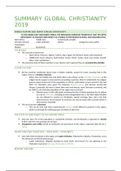SUMMARY GLOBAL CHRISTIANITY
2019
MIDDLE EASTERN AND NORTH AFRICAN CHRISTIANITY
IN THE MIDDLE EAST AND NORTH AFRICA, THE PREVAILING CHRISTIAN TRADITON IS THAT OP COPTIC
ORTHODOXY, ALTHOUGH CHRISTIANITY AS A WHOLE IN THIS REGION IS SMALL AND DECLINING STILL.
North Africa Middle East economically unstable
Christian minority Coptic Orthodox Decline antagonism and conflict
Colonization
Sharkey Ecumenism
THE REGION
The countries involved are:
o North Africa: Morocco, Algeria, Tunisia, Libya, Egypt, the Western Sahara and Mauritania.
o Middle East: Israel, Lebanon, Saudi Arabia, Yemen, Oman, Turkey, Syria, Iraq, Jordan, Kuwait,
Qatar, UAE, and Bahrain.
The economic state of these countries is very diverse, but in general they are economically unstable.
A SHORT HISTORY
All the countries mentioned above have a Muslim majority, except for Israel, meaning that in this
region, there is a Christian minority.
o before this, the Middle East and North Africa were known as the Christian heartland, as the
religion has its origins in Israel and its surrounding countries. After it’s initial birth, the religion
grew to about 50 percent of the population in 350 CE, until Islamic armies arrived in the mid
600’s CE. Christians were given the infamous Dhimmi status, and became second-rate
citizens. Eventually, also due to lower birth rates and disease, most Christians converted, and
by 1000 CE, the Christian population in this region was cut in half.
Dhimmi status is still valid today, meaning that the Christian populace has to adhere
to a set of extra laws, including an anti-evangelization law, a law that states Muslims
are not allowed to convert to Christianity, special marriage laws, and a law that
states that any and all repairs to churches can only be made with a permit (which is
almost never awarded).
This area has been colonized.
o This can be seen well when examining the borders of the different countries in this region,
which cut through the existing groups and tribes at that time.
THE STATE OF CHRISTIANITY IN THIS REGION TODAY
Only less than 5% of the population is considered Christian, and Christianity is expected to decline
further with the ever growing rate of Islam.
Antagonism and conflict aimed at Christianity are paramount in this region, especially after the Arab
Spring.
MAJOR CHRISTIAN TRADITIONS / THEOLOGIES / MOVEMENTS
Over half of the Christians in this region are Coptic Orthodox, followed by Catholics, Protestants, and a
few Nestorian and Pentecostal groups.
o Coptic Orthodoxy: allegedly founded by Saint Mark; best known for not adhering to the
Chalcedon counsel on the issue of the nature of Christ.
READING ASSIGNED
, Sharkey states in his article that in the middle east and north Africa a movement for ecumenism grows
as a direct result of the Christians becoming and ever shrinking minority.
Sharkey also states that Christians have had an influence on heritage in the Middle East on the
political, economic and cultural plain, because of Islamic civilization has been build on top of theirs
since the 8th century CE.
SUB SAHARAN AFRICAN CHRISTIANITY
THE PREVAILING CHRISTIAN MOVEMENT IN SUB SAHARAN AFRICA IS THE RAPIDLY GROWING
PENTECOSTALISM, DRIVEN BY THE REGION’S ECONOMIC WEAKNESS AND HIGH FERTILITY RATES.
Colonization Economic weakness Social & Political problems
Pentecostalism Rapid Growth High fertility Shifting heartland
Boylston Food as ID-marker
Kalu Spread of Christianity
Williams Chrislam Bricolage movement
THE REGION
The region consists of 47 countries in Sub Saharan Africa, including Ethiopia from the reading.
The economic state of this region is generally unstable, particularly through still existing social and
political problems stemming from its colonial and postcolonial history.
o Social: health crises, high rate of illiteracy, and a very low life expectancy.
A SHORT HISTORY
This area has been colonized, and later received faulty loans and aids, creating insurmountable debts.
In the 20th century, decolonization, indigenization and local evangelism led to Christianization.
THE STATE OF CHRISTIANITY IN THIS REGION TODAY
About 25% of the world population of Christians is from this region.
In this region Christianity is growing rapidly, for a number of reasons:
o Secularization is slower here, and in some countries is does not appear at all.
Religious activity is thriving.
o High fertility rates: It’s possible that the region will within the century reach a majority of
Christians globally.
Because of the shift in populace, Africa is becoming more influential in Christianity as a global
movement, shifting the Christian heartland from Europe to Africa.
MAJOR CHRISTIAN TRADITIONS / THEOLOGIES / MOVEMENTS
The largest movement in this region is Pentecostalism, even in Non-Pentecostal churches.
o This movement is known for an emphasis on feeling, experience and the interventions of the
Holy Spirit in daily suffering.
o Most members and churches affiliated with the movement are believers of the Prosperity
Gospel, which takes that if one’s belief is strong enough, material and health gain will follow.
o Another well known aspect of this movement is the allowance of cases of Glossolalia
(speaking in tongues).
Reasons why Pentecostalism is so successful: Lack of a colonial and/or outsider connection; More
authentically African; An experiential approach to life, instead of an intellectual one; Empowering of
women, the poor, and the transforming of poor communities; Relatively cheap to set up and maintain
as a religion.
READING ASSIGNED
Boylston states in their article on food practices in Ethiopia that food has gained the function of an ID-
marker between Christians and other faiths in the country. This directly influences social behavior.
Kalu mentions in their article on the spread of Christianity in West Africa by Portuguese clergy and
Protestant missionaries, and how in the Sub-Saharan region Islam is still the biggest religion.





